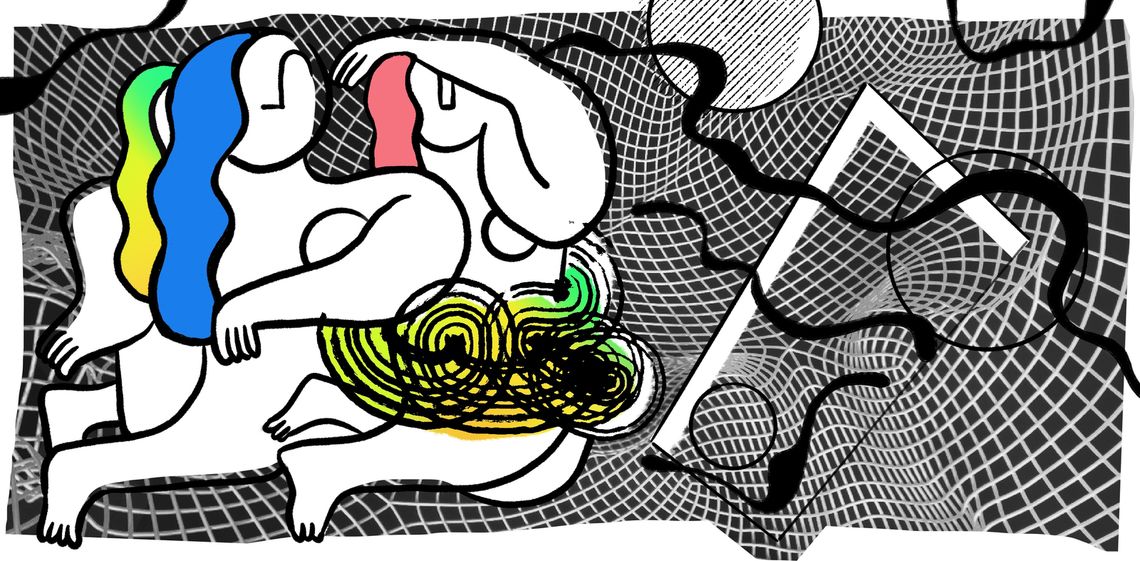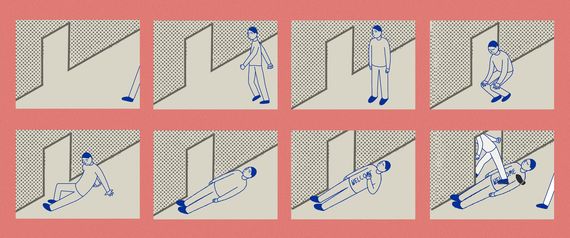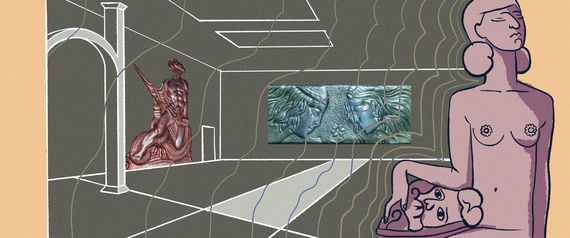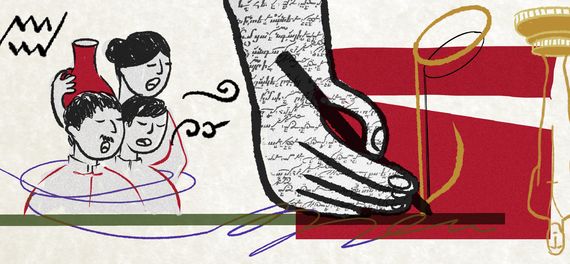Sat Jun 26 2021 · 7 min read
The EDM Kitchen։ Electronic Dance Music in the Context of Gender

By Eva Khachatryan

Illustration by Armine Shahbazyan.
In 2005, an international festival (Women’s Dialogue International Festival: exhibition, symposium, series of workshops), in which only women participated was held in Yerevan to mark March 8. One of the guests, Rosa Reitsamer from Austria, a music sociologist and sometimes DJ, conducted a DJ workshop for women and girls. Female DJs were not yet active in Armenia at that time, but electronic dance music was gradually gaining momentum. The Cascade Club—presenting the city's best DJs—began operating in the late 1990s through to the early 2000s, in one of the levels of the then-abandoned, unfinished Cascade. Certain artists (Diana Hakobyan, Arman Grigoryan, David Kareyan, Varuzhan Vardanyan) were also involved in the establishment of the club, providing the atmosphere of the place with their graffiti. In addition to this club, there were some discos in the city. The most popular was Monte Cristo, where DJs known to us from the radio stations of that time played. DJ Vakcina’s career also started with radio. She then moved on to clubs and all possible platforms where electronic dance music was in demand.
In one of our conversations with Reitsamer, she noted that the sphere of electronic dance music (EDM), as a relatively new cultural phenomenon and field, could have been occupied by women. But even here, the role and presence of men is predominant, and women, as in many other fields, have to fight for a place and for fair representation. Some foreign studies on the activity of female DJs state that women often face sexism and often do not even fight to stay visible in the field and advance their career. In parallel with this phenomenon, self-organizing platforms have been created in Europe and America which are more feminist and queer oriented—representing women, queer and other identities—thus securing their free activity and paving the way toward bigger stages in the future.
Anna Gavanas and Rosa Reitsamer, who have long studied the field of EDM in the context of gender, have conducted numerous interviews with both female and male DJs to understand the conditions under which they work, and how they can develop their careers and succeed.
In one of the interviews, a female DJ living in Vienna says that it was very difficult to pave the way to the position she has today. After years of being ignored and disrespected by the men in charge of the EDM industry, she eventually built her own network and has even managed to open a club, but she has traveled a long, difficult road to achieve all this. At the same time, conversations with male DJs give the impression that the brevity and ease of their path to success was due to pure coincidence—being in the right place at the right time. These two, frequently recurring, approaches define the EDM sphere from a gender perspective. Consequently, "…Self-organization and work on the one hand, chance and luck on the other – these are the central concepts of gender-specific narratives which ultimately contribute to the factor of being included or not in the informal environment of the field,” conclude Gavanas and Reitsamer.
Maybe it is still difficult to make such assessments in the Armenian context simply because the sphere is insufficiently developed, but the elements of gender inequality are also present here. Men are still quantitatively dominant, and their participation in important musical events is always more likely. However, in general, it should be noted that today, in both global and local contexts, the role of women is growing. It is difficult to say whether this is conditioned purely by the radical change of cultural-political paradigms, or that women are actually valued for their professional merit. In any case, today they have more opportunities to be educated, to self-organize, to create professional networks or to become active participants of these networks.
Another platform for female DJs playing vinyl records is Frauengedeck, founded in Berlin by DJ Sabine Hoffmann. Frauengedeck also appeared in Yerevan in 2017-2018, with the participation of various female DJs. Henna Onna (then Lucy Sowa) and Anaïs Paws also took part in this festival event.
With the development of the industry, new clubs were opened in Armenia, new platforms were created, where men remain dominant, but female DJs—with their characteristic femininity, and particular sensitivity and creativity in delivering music—are able to relay diversity, and moderate the macho environment. Some of them—Henna Onna, Anaïs Paws and Nancy Movs—enjoy popularity and perform in various clubs and platforms, as well as having participated in international projects. The range of music played by Henna Onna includes jazz-funk and electronic music, especially house music. Her performances are distinguished by the positive energy they radiate. The uniqueness of Anaïs Paws lies in the unexpectedness and eclecticism of her music list. Her sets are distinguished by a combination of afro rhythms, oriental disco, acid, house and techno elements. Nancy Movs is probably the most consistent in terms of her preference toward techno music; she was quite successful in the 2019 Boiler Room in Yerevan, in no way inferior to the men on the same stage, in terms of professionalism and performance. Lucia Kagramanyan, who lives in Vienna and Moscow and who has recently become associated with the Yerevan music environment, stands out with her unique style and creativity. In addition to delivering live sets in different parts of the city—which are quite diverse in terms of genre—Lucia is the author of the Panorama Yerevan program that is broadcast by the NTS online radio station. Within the framework of this program, she also presents the Armenian music archives she studies and revives. These archives include both urban folklore and classical Armenian music.
In general, the activity of female DJs in Armenia is important not only from a musical point of view, but also in terms of reviewing the polarized cultural perceptions of EDM. The more diverse and changing approaches of women usually come to cut through the aggressiveness and sexualization that are often present in EDM.
It is gratifying that clubs (currently Polygraph, Fermata and Basement are the three most lively) are not the only places where you can enjoy electronic dance music. In addition to the already established platforms, such as the Armenian DJ Association which organizes international events from time to time, there is the Kitchen Recordings Label, which is affiliated with the Kitchen Lab. The independent initiative Bohemnots, which is based on collective creativity, is known for its alternativeness. In addition to throwing parties from time to time in various places, Bohemnots also presents electronic music through an online radio channel. It is on this platform that not only can DJs and musicians with relatively experimental musical preferences try out their hand, but also novice DJs. And the openness of this very platform, to create a freer and inspiring atmosphere, allows female DJs to be more courageous and to play more often for EDM fans.
The “Plug-in” platform, created by the efforts of Anna Vahrami and Vanane Boryan, was quite active in the field of electronic music education in 2018-2020. Within a few years, they managed to organize intensive workshops with the participation of both local and foreign sound artists and DJs. Thanks to the platform’s educational program, the participants were able to get to know the basic formats of creating and presenting electronic music. This initiative also stimulated interest in the field, allowing many to take their first steps into the field of DJing. Also noteworthy is the Polygraph Club’s DJ School, which is staffed by DJs cooperating with Polygraph, and whose courses are open to both girls and boys.
It goes without saying that young people who are not indifferent to electronic music strive to master the secrets of DJing. And today, new performing practices and the new names of young female DJs are being outlined and formed around Polygraph and Bohemnots. These names include GFRND, Lychee, Missteikk, members of the Jrimurmur band Holly F and Kamunts, and others. Melineh and Anna (: ana) also present their original music. Such developments speak of the liberalization of the general cultural sphere in Armenia. These women are charting this promising musical perspective, and the future belongs to them.
Et cetera
The articles in this section of EVN Report attempt to turn the tide and give a much-needed critical spotlight to the forgotten, ignored, misunderstood, unseen, silenced and even derided cultural phenomena that weave the fabric of our collective past and present. From the mundane to the extraordinary, the topics addressed here reveal the remarkable dynamism of both historical, as well as contemporary Armenian social practices. By stressing the complexities of these experiences, we hope to ignite new dialogues and insights about the evolving implications of what it means to be Armenian in the rapids of our globalized world.









